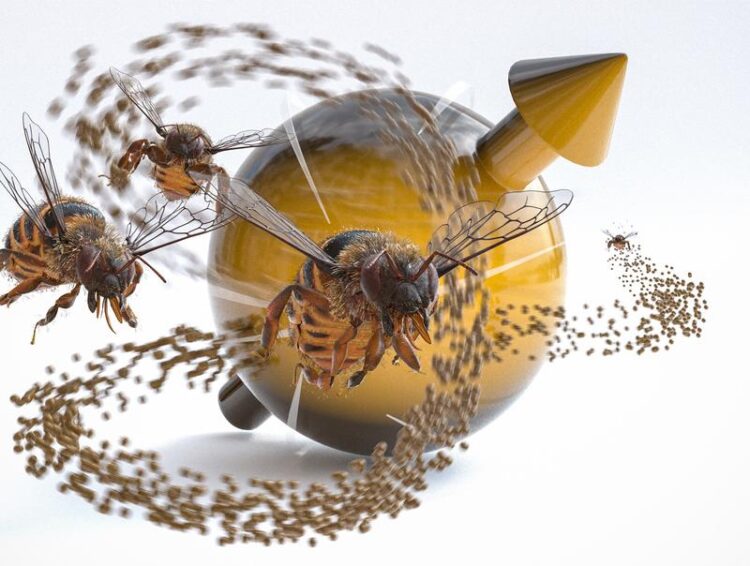When quantum particles fly like bees

"Levy flights" describe statistical properties of elementary quantum magnets as well as of bees foraging for food.
Credit: Christoph Hohmann (MCQST Cluster)
A quantum system consisting of only 51 charged atoms can assume more than two quadrillion different states. Calculating the system’s behavior is a piece of cake for a quantum simulator. Yet even with today’s supercomputers it is almost impossible to verify the result. A research team from the University of Innsbruck and the Technical University of Munich (TUM) has now shown how these systems can be described using equations from the 18th century.
At first glance, a system consisting of 51 ions may appear simple. But even if these charged atoms can only assume two different states, there will be more than two quadrillion (10^15) different configurations which the system can realize.
The behavior of such a system can therefore hardly be calculated with conventional computers. Especially since once an excitation has been introduced into the system, it can propagate in leaps and bounds. It follows a statistic known as Lévy flight.
A characteristic of the movement of such a quantum particle is that, in addition to the smaller jumps, also significantly larger jumps occur. This phenomenon can also be observed in the flight of bees and in unusual fierce movements in the stock market.
Simulating quantum dynamics: A classically hard problem
While simulating the dynamics of a complex quantum system is a very hard problem even for super computers, the task is a piece of cake for quantum simulators. But how are you supposed to check the results of a quantum simulator when you cannot recalculate them?
Theoretical predictions suggested that it might be possible to represent at least the long-term behavior of such systems with equations as those developed by the Bernoulli brothers in the 18th century to describe the behavior of fluids.
To test this hypothesis, the research team used a quantum system that simulates the dynamics of quantum magnets. With this they were able to show that after an initial regime in which quantum-mechanical effects dominate, the system can be described by equations known from fluid dynamics.
Furthermore, they showed that the very same Lévy flight statistics which describes the search strategies of bees also describes the fluid-dynamics in this quantum system.
Trapped ions as a platform for controlled quantum simulations
The quantum simulator was built at the Institute for Quantum Optics and Quantum Information (IQOQI) of the Austrian Academy of Sciences on the campus of the University of Innsbruck, Austria. “Our system effectively simulates a quantum magnet by representing the north and south poles of an elementary magnet by two energy levels of the ions,” says IQOQI Innsbruck scientist Manoj Joshi.
“Our biggest technical advance was that we succeeded in controlling each one of the 51 ions individually,” observes Manoj Joshi. “As a result, we were able to investigate the dynamics of different initial states, which was necessary to demonstrate the emergence of the fluid dynamics.”
“While the number of qubits and the stability of the quantum states is currently still very limited, there are problems for which we can already now use the enormous computing power of quantum simulators,” says Michael Knap, Professor for Collective Quantum Dynamics at the Technical University of Munich.
“Near-term quantum simulators and quantum computers will be ideal platforms to explore the dynamics of complex quantum systems,” explains Michael Knap. “Now we know that after a certain point in time these systems follow the laws of classical fluid dynamics. Any strong deviation from that is an indication that the simulator is not working properly.”
Wissenschaftliche Ansprechpartner:
Prof. Dr. Michael Knap
Professorship of Collektive Quantum Dynamics
Technical University of Munich
James-Franck-Str. 1, 85748 Garching, Germany
Tel.: +49 89 289 53777 – E-Mail: michael.knap@ph.tum.de
Web: https://www.ph.nat.tum.de/cmt/home/
Prof. Dr. Christian RoosInstitute for Experimental Physics
Universität Innsbruck
Technikerstraße 25, 6020 Innsbruck, Austria
Tel.: +43 512 507 4728 – E-Mail: christian.roos@uibk.ac.at
Web: https://www.uibk.ac.at/sp-physik/research-groups/c-ross.html.en
Originalpublikation:
Observing emergent hydrodynamics in a long-range quantum magnet. M. K. Joshi, F. Kranzl, A. Schuckert, I. Lovas, C. Maier, R. Blatt, M. Knap, C. F. Roos. Science, 13.05.2022 – DOI: 10.1126/science.abk2400 [https://arxiv.org/abs/2107.00033]
Media Contact
All latest news from the category: Physics and Astronomy
This area deals with the fundamental laws and building blocks of nature and how they interact, the properties and the behavior of matter, and research into space and time and their structures.
innovations-report provides in-depth reports and articles on subjects such as astrophysics, laser technologies, nuclear, quantum, particle and solid-state physics, nanotechnologies, planetary research and findings (Mars, Venus) and developments related to the Hubble Telescope.
Newest articles
Faster, more energy-efficient way to manufacture an industrially important chemical
Zirconium combined with silicon nitride enhances the conversion of propane — present in natural gas — needed to create in-demand plastic, polypropylene. Polypropylene is a common type of plastic found…

Energy planning in Ghana as a role model for the world
Improving the resilience of energy systems in the Global South. What criteria should we use to better plan for resilient energy systems? How do socio-economic, technical and climate change related…

Artificial blood vessels could improve heart bypass outcomes
Artificial blood vessels could improve heart bypass outcomes. 3D-printed blood vessels, which closely mimic the properties of human veins, could transform the treatment of cardiovascular diseases. Strong, flexible, gel-like tubes…





















